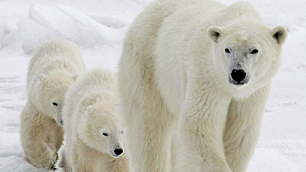Demand for Polar Bear Hides Soars: Canadian Auction House
 One of Canada’s largest fur auction houses says it cannot meet the soaring demand for polar bear hides, provoking concerns about overhunting in southern Hudson Bay and other areas..
One of Canada’s largest fur auction houses says it cannot meet the soaring demand for polar bear hides, provoking concerns about overhunting in southern Hudson Bay and other areas..
Demand and prices for polar bear hides have been escalating over the past five seasons, says an official with Fur Harvesters Auction Inc. in North Bay, Ont. Russians are particularly interested in the hides, he said.
“The supply does not even come close to meeting the demand,” Mark Downey, the auction house’s chief executive officer, told CBC News.
At the company’s most recent sale in January, polar bear hides sold for an average of $5,000, Downey said. One sold for a record high of $11,000.
Each buyer at the sale wanted all 80 of the polar bear hides on offer but had to settle for two or three hides each, he said.
“There’s a lot of interest for really top-quality specimens, 10-footers-plus, well-handled bears for the Russian market,” he said. “There’s a lot of Russian businessmen or what have you that would like to have a polar bear rug.”
Demand in Russia, Asia, Canada
Downey added that polar bear hides are also wanted for life-size mounts or displays for museums and airports.
“The top goods are ending up going to Russia, whereas the other ones are going basically all over,” he said. “They’re going to China, they’re going into Canada … could be into Japan.”
Hunters in Nunavik, a predominantly Inuit region in northern Quebec, have killed an unusually high number of polar bears this year, and demand has been cited as a reason.
Hunters in Inukjuak, Que., have told CBC News they have killed at least 60 polar bears since January in southern Hudson Bay. On average over the last five years, fewer than four polar bears a year were killed.
Quebec government officials have said the demand for polar bear hides is so high that buyers are purchasing hides with the fat still on them.
Wildlife group calls for management system
The demand for polar bear hides can result in overhunting, said Pete Ewins, a senior officer in charge of species for World Wildlife Fund Canada.
Ewins said Quebec needs a good polar bear management system, similar to one in Nunavut.
Unlike Nunavut, where each community is allowed an annual hunting quota for polar bears, Quebec does not have a fixed quota system.
Inuit hunters in Sanikiluaq, Nunavut, who also hunt from the southern Hudson Bay polar bear population, have said they are concerned the large hunt in Nunavik could result in fewer bears for them to harvest.
Ontario also has no fixed quota system for polar bears, but that province’s government has a management agreement with Cree people there.
Ewins applauded the Quebec government’s move to call a meeting of polar bear hunters and government officials from that province, Nunavut and Ontario in June.
“Although it’s driven, I think, by damage-control reasons, it probably will result in a shift in priorities and I think Quebec will catch up,” he said. “I’m an optimist.”
Polar bear experts have been calling for polar bear management agreements that are shared between jurisdictions.
Figures obtained from Environment Canada show the number of international export permits issued for polar bear hides has risen from 219 in 2005 to 320 in 2010.


